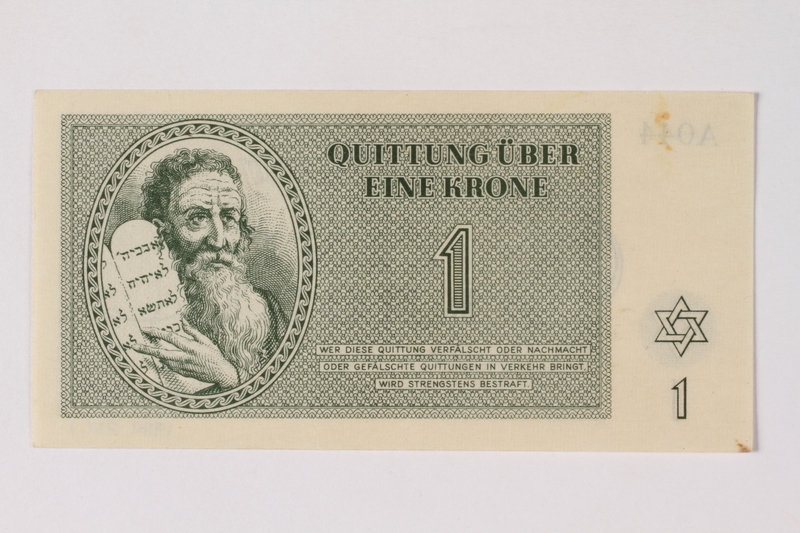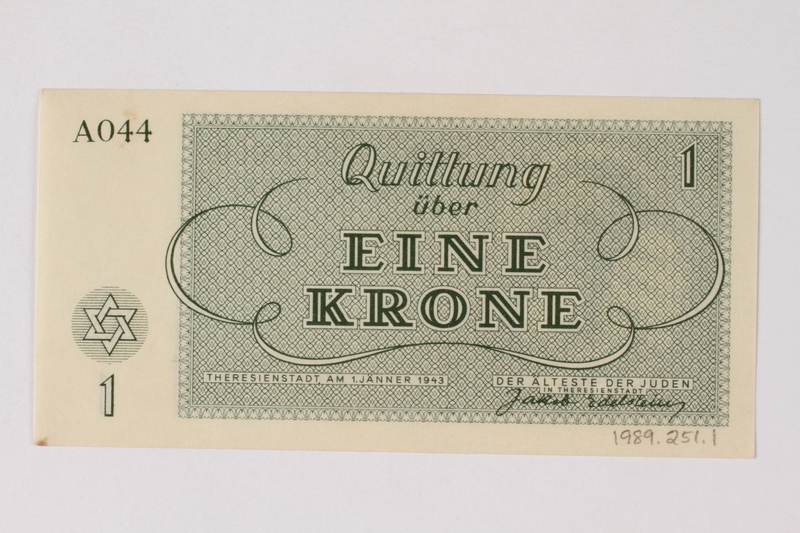Overview
- Brief Narrative
- Theresienstadt scrip, valued at 1 (eine) krone acquired there by Rene W. Schonfeldt, 12, when he was a prisoner in Theresienstadt (Terezin) ghetto-labor camp from September 1944-May 1945. The ghetto currency was distributed from May 1943, and Rene saved one of each denomination: 1, 2, 5, 10, 20, 50, 100. The scrip was issued to create a false appearance of normalcy in the camp. There was nothing to obtain with the scrip. Soon after Hitler came to power in Germany in 1933, Rene's parents Hans and Hanna fled Berlin with their infant son to Hilversum, Netherlands. In May 1940, Germany occupied the Netherlands. In January 1942, Rene and his parents were interned in Westerbork transit camp. In September 1944, they were deported to Theresienstadt. Soon after their arrival, his father was sent to Auschwitz and murdered. Theresienstadt was liberated by Soviet troops on May 9, 1945. Rene and his mother were repatriated to the Netherlands. They left for America in 1948.
- Date
-
received:
1944 September-1945 May
- Geography
-
received:
Theresienstadt (Concentration camp);
Terezin (Ustecky kraj, Czech Republic)
- Credit Line
- United States Holocaust Memorial Museum Collection, Gift of Barbara and Ronald W. Schonfeld In memory of Hans Schönfeldt
- Markings
- face, center, green ink : QUITTUNG ÜBER / EINE KRONE / 1 [Receipt / of / ONE CROWN]
face, lower center, green ink : WER DIESE QUITTUNG VERFÄLSCHT ODER NACHMACHT / ODER GEFÄLSCHTE QUITTUNGEN IN VERKEHR BRINGT. / WIRD STRENGSTENS BESTRAFT [ANYONE WHO FALSIFIES OR DISTORTS OR FAKES THIS RECEIPT, OR COUNTERFEITS RECEIPT, WILL BE STRICTLY PUNISHED]
face, lower right corner, green ink : 1
reverse, upper left corner, plate letter and number, green ink : A044
reverse, lower left and upper right corner, green ink : 1
reverse, center, green ink : Quittung / über / EINE KRONE
reverse, lower center, green ink : THERESIENSTADT, AM 1.JANNER 1943 DER ALTESTE DER JUDEN / IN THERESIENSTADT / Jakob Edelstein [THERESIENSTADT, ON 1. JANUARY 1943 THE ELDER OF THE JEWS IN THERESIENSTADT / Jakob Edelstein] - Contributor
-
Subject:
Ronald W. Schonfeld
Printer: National Bank of Prague
Designer: Peter Kien
Issuer: Der Alteste der Juden in Theresienstadt
- Biography
-
Rene Wolfgang Schönfeldt (Schoenfeldt) was born on February 8, 1932, in Berlin, Germany, to Jewish parents, Hans Phillip and Hanna Goldmann Schonfeldt. Hans was born in Berlin to Willi and Marie Schonfeldt on March 14, 1902. Hanna was born on September 8, 1903 in Berlin. In January 1933, Hitler was appointed Chancellor and the Nazi dictatorship was firmly established by summer. The regime immediately enacted laws to persecute and disenfranchise the Jewish population. Hans, Hanna, and Rene fled to the Netherlands that year and settled in Hilversum.
In May 1940, Germany invaded the Netherlands. The occupation government was led by SS Reich Commissar Seyss-Inquart and anti-Jewish policies were immediately put in place. On January 9, 1941, Rene and his parents were sent to an internment camp in Westerbork, first set-up to hold non-Dutch Jews. It then became a transit camp which also processed and detained Dutch Jews prior to deportation to extermination and concentration camps in the east. On April 29, 1942, all Jews were required to wear Star of David badges at all times. By summer, there were frequent departures of large scale transports of Jews to the east. On September 4, 1944, Rene, Hans, and Hanna were deported to Theresienstadt ghetto-labor camp in German occupied Czechoslovakia. Soon after their arrival, on September 29, his father Hans was sent to Auschwitz concentration camp in Poland. Near the end of the war in spring 1945, the German were evacuating camps in the east and sending inmates to Theresienstadt. Rene searched each arriving transport, hoping to find his father, but he never saw him again. Rene and his mother were in Theresienstadt when it was liberated by Soviet troops on May 9, 1945.
Rene and his mother Hanna were repatriated to the Netherlands. His father was presumed killed at Auschwitz. Hanna married Ulrich (Martin) Gross on July 16, 1947, in Hilversum. Ulrich, born July 11, 1885, was also from Berlin. The three immigrated to the United States on October 16, 1948, sailing from England to New York on board the Queen Elizabeth. They settled in California. Rene changed his name to Ronald Waldo Schonfeld. He married Barbara in 1974. Hanna, 101, passed away on May 11, 2004.
Franz Peter Kien was born January 1, 1919, in Varnsdorf, Czechoslovakia (Czech Republic), to Leonard and Olga Frankl Kien. His father Leonard was born in 1886, in Varnsdorf, and was a member of the German-speaking Jewish population in the, the Sudetenalnd, which bordered Germany. Leonard was a textile manufacturer with his own factory. Peter’s mother Olga was born in 1898, in Bzenec, Austro-Hungary (Czech Republic), to Jewish parents. After 1929, the Kien family moved to Brno. Peter enrolled at the German Gymnasium, where he excelled at drawing, painting, and writing. In 1936, he graduated and moved to Prague to study at the Academy of Fine Arts. He also attended the Officina Pragensis, a private graphic design school run by a well-known Jewish artist, Hugo Steiner-Prag.
On September 29, 1938, Germany annexed the Sudetenland. On March 15, 1939, Germany invaded Prague and annexed the Bohemia and Moravia provinces of Czechoslovakia, ruled by a Reich Protector. Jews were banned from participation in government, businesses, and organization, including schools. Peter had to leave the Academy, but continued to study at the Officina Pragensis. He also taught at Vinohrady Synagogue. In September 1940, Peter married Ilse Stranska, who was born on May 9, 1915, in Pilsen, to Jewish parents.
In late September 1941, Reinhard Heydrich, the SS head of RSHA, Reich Main Security Office, became Reich Protector. Soon there were regular deportations of Jews to concentration camps. At the end of November, Theresienstadt concentration and transit camp near Prague got its first shipment of Jewish prisoners. On December 14, Peter was transported to Theresienstadt ghetto-labor camp. He was assigned to the technical department where he worked as a draftsman and designer alongside other artists, including Bedrich Fritta, Leo Haas, and Jiri Lauscher. On July 16, 1942, Peter’s wife Ilse arrived in the camp. On January 30, 1943, Peter’s parents Leonard and Olga were transported from Bzenec to Terezin. Peter was assigned major projects by the Jewish Council that administered the camp for the Germans, such as the scrip receipts used in place of money in the camp. He secretly documented the inmate’s daily life, creating portraits and other drawings, and wrote plays, poems, and an operatic libretto. On October 16, 1944, Peter’s wife Ilse and his parents Leonard and Olga were selected for deportation. Peter volunteered to go with them. Before leaving, Peter and his family were sent to Auschwitz concentration camp in German-occupied Poland. Peter survived the selection process, soon fell ill, likely with typhus, and died at age 25 in late October 1944. His wife and parents were killed at Auschwitz. Some of the work that Peter left with other prisoners or hid at Theresienstadt survived and has been exhibited worldwide.
Physical Details
- Classification
-
Exchange Media
- Category
-
Money
- Object Type
-
Scrip (aat)
- Physical Description
- Theresienstadt scrip printed on rectangular offwhite paper in green ink. The face has a vignette of Moses, with a long beard and wrinkled brow, holding 2 stone tablets with the 10 Commandments in Hebrew. To the right is the denomination 1 and German text. The background rectangle has an intricate latticework pattern. The right side has a wide margin with the denomination 1 below a Star of David. The reverse has a rectangle with a background of interlocked squares overprinted with the denomination 1 in the upper right corner, and German text, an engraved signature, and a large scrollwork line in the center. The left side has a wide margin with the denomination 1 below a Star of David within a striped circle. The plate letter and number are in the upper left corner. It is in good condition with a small stain.
- Dimensions
- overall: Height: 2.000 inches (5.08 cm) | Width: 4.000 inches (10.16 cm)
- Materials
- overall : paper, ink
Rights & Restrictions
- Conditions on Access
- No restrictions on access
- Conditions on Use
- No restrictions on use
Keywords & Subjects
- Topical Term
- Child concentration camp inmates--Czech Republic--Terezin (Ustecky kraj)--Biography. Concentration camp inmates--Czech Republic--Terezin (Ustecky kraj)--Biography. Deportees--Netherlands--Biography. Holocaust, Jewish (1939-1945)--Czech Republic--Terezin (Ustecky kraj)--Personal narratives. Holocaust, Jewish (1939-1945)--Netherlands--Personal narratives. Jewish children in the Holocaust--Biography. Jewish refugees--Netherlands--Biography.
Administrative Notes
- Legal Status
- Permanent Collection
- Provenance
- The scrip was donated to the United States Holocaust Memorial Museum in 1989 by Ronald W. Schonfeld.
- Funding Note
- The cataloging of this artifact has been supported by a grant from the Conference on Jewish Material Claims Against Germany.
- Record last modified:
- 2023-02-23 16:44:21
- This page:
- https://collections.ushmm.org/search/catalog/irn20210
Download & Licensing
In-Person Research
- By Appointment
- Request 21 Days in Advance of Visit
- Plan a Research Visit
- Request to See This Object
Contact Us
Also in Ronald W. Schonfeld collection
The collection consists of seven pieces of Theresienstadt scrip and a Star of David badge relating to the experiences of Rene W. Schonfeldt (later Ronald Schonfeld) during the Holocaust in German occupied Netherlands and as a prisoner in Westerbork internment camp and Theresienstadt ghetto-labor camp in German occupied Czechoslovakia. Photograph albums, loose photographs illustrating the experiences of the Schonfeld family in Germany and the Netherlands. Hans, Hanna, and Rene emigrated from Germany to the Netherlands before the war. The family was deported on September 6, 1944 to Theresienstadt Concentration Camp in the Czech Republic. Although Hanna and Rene renamed in Theresienstadt and were liberated there, on September 29, Hans was deported to Auschwitz, where he is presumed to have died on February 28, 1945. Collection includes numerous photographs and photograph albums dating from the turn of the 20th century from the 1930s through the 1970s.
Date: 1942 April-1944
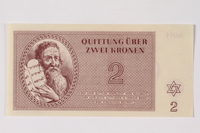
Theresienstadt ghetto-labor camp scrip, 2 kronen note
Object
Theresienstadt scrip, valued at 2 (zwei) kronen acquired there by Rene W. Schonfeldt, 12, when he was a prisoner in Theresienstadt (Terezin) ghetto-labor camp from September 1944-May 1945. The ghetto currency was distributed from May 1943, and Rene saved one of each denomination: 1, 2, 5, 10, 20, 50, 100. The scrip was issued to create a false appearance of normalcy in the camp. There was nothing to obtain with the scrip. Soon after Hitler came to power in Germany in 1933, Rene's parents Hans and Hanna fled Berlin with their infant son to Hilversum, Netherlands. In May 1940, Germany occupied the Netherlands. In January 1942, Rene and his parents were interned in Westerbork transit camp. In September 1944, they were deported to Theresienstadt. Soon after their arrival, his father was sent to Auschwitz and murdered. Theresienstadt was liberated by Soviet troops on May 9, 1945. Rene and his mother were repatriated to the Netherlands. They left for America in 1948.
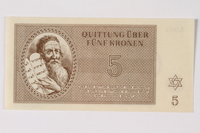
Theresienstadt ghetto-labor camp scrip, 5 kronen note
Object
Theresienstadt scrip, valued at 5 (funf] kronen acquired there by Rene W. Schonfeldt, 12, when he was a prisoner in Theresienstadt (Terezin) ghetto-labor camp from September 1944-May 1945. The ghetto currency was distributed from May 1943, and Rene saved one of each denomination: 1, 2, 5, 10, 20, 50, 100. The scrip was issued to create a false appearance of normalcy in the camp. There was nothing to obtain with the scrip. Soon after Hitler came to power in Germany in 1933, Rene's parents Hans and Hanna fled Berlin with their infant son to Hilversum, Netherlands. In May 1940, Germany occupied the Netherlands. In January 1942, Rene and his parents were interned in Westerbork transit camp. In September 1944, they were deported to Theresienstadt. Soon after their arrival, his father was sent to Auschwitz and murdered. Theresienstadt was liberated by Soviet troops on May 9, 1945. Rene and his mother were repatriated to the Netherlands. They left for America in 1948.

Theresienstadt ghetto-labor camp scrip, 10 kronen note
Object
Theresienstadt scrip, valued at 10 (zehn) kronen acquired there by Rene W. Schonfeldt, 12, when he was a prisoner in Theresienstadt (Terezin) ghetto-labor camp from September 1944-May 1945. The ghetto currency was distributed from May 1943, and Rene saved one of each denomination: 1, 2, 5, 10, 20, 50, 100. The scrip was issued to create a false appearance of normalcy in the camp. There was nothing to obtain with the scrip. Soon after Hitler came to power in Germany in 1933, Rene's parents Hans and Hanna fled Berlin with their infant son to Hilversum, Netherlands. In May 1940, Germany occupied the Netherlands. In January 1942, Rene and his parents were interned in Westerbork transit camp. In September 1944, they were deported to Theresienstadt. Soon after their arrival, his father was sent to Auschwitz and murdered. Theresienstadt was liberated by Soviet troops on May 9, 1945. Rene and his mother were repatriated to the Netherlands. They left for America in 1948.
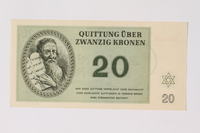
Theresienstadt ghetto-labor camp scrip, 20 kronen note
Object
Theresienstadt scrip, valued at 20 (zwanzig) kronen acquired there by Rene W. Schonfeldt, 12, when he was a prisoner in Theresienstadt (Terezin) ghetto-labor camp from September 1944-May 1945. The ghetto currency was distributed from May 1943, and Rene saved one of each denomination: 1, 2, 5, 10, 20, 50, 100. The scrip was issued to create a false appearance of normalcy in the camp. There was nothing to obtain with the scrip. Soon after Hitler came to power in Germany in 1933, Rene's parents Hans and Hanna fled Berlin with their infant son to Hilversum, Netherlands. In May 1940, Germany occupied the Netherlands. In January 1942, Rene and his parents were interned in Westerbork transit camp. In September 1944, they were deported to Theresienstadt. Soon after their arrival, his father was sent to Auschwitz and murdered. Theresienstadt was liberated by Soviet troops on May 9, 1945. Rene and his mother were repatriated to the Netherlands. They left for America in 1948.
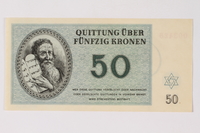
Theresienstadt ghetto-labor camp scrip, 50 kronen note
Object
Theresienstadt scrip, valued at 50 [funfzig) kronen acquired there by Rene W. Schonfeldt, 12, when he was a prisoner in Theresienstadt (Terezin) ghetto-labor camp from September 1944-May 1945. The ghetto currency was distributed from May 1943, and Rene saved one of each denomination: 1, 2, 5, 10, 20, 50, 100. The scrip was issued to create a false appearance of normalcy in the camp. There was nothing to obtain with the scrip. Soon after Hitler came to power in Germany in 1933, Rene's parents Hans and Hanna fled Berlin with their infant son to Hilversum, Netherlands. In May 1940, Germany occupied the Netherlands. In January 1942, Rene and his parents were interned in Westerbork transit camp. In September 1944, they were deported to Theresienstadt. Soon after their arrival, his father was sent to Auschwitz and murdered. Theresienstadt was liberated by Soviet troops on May 9, 1945. Rene and his mother were repatriated to the Netherlands. They left for America in 1948.
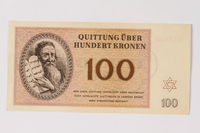
Theresienstadt ghetto-labor camp scrip, 100 kronen note
Object
Theresienstadt scrip, valued at 100 (eine hundert) kronen acquired there by Rene W. Schonfeldt, 12, when he was a prisoner in Theresienstadt (Terezin) ghetto-labor camp from September 1944-May 1945. The ghetto currency was distributed from May 1943, and Rene saved one of each denomination: 1, 2, 5, 10, 20, 50, 100. The scrip was issued to create a false appearance of normalcy in the camp. There was nothing to obtain with the scrip. Soon after Hitler came to power in Germany in 1933, Rene's parents Hans and Hanna fled Berlin with their infant son to Hilversum, Netherlands. In May 1940, Germany occupied the Netherlands. In January 1942, Rene and his parents were interned in Westerbork transit camp. In September 1944, they were deported to Theresienstadt. Soon after their arrival, his father was sent to Auschwitz and murdered. Theresienstadt was liberated by Soviet troops on May 9, 1945. Rene and his mother were repatriated to the Netherlands. They left for America in 1948.
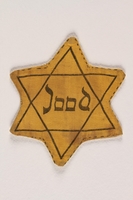
Star of David badge printed Jood worn by German Jewish boy
Object
Yellow cloth Star of David patch, with Jood for Jew, worn by Rene W. Schonfeldt, 10, in German occupied Netherlands beginning April 29, 1942, when he was interned in Westerbork transit camp. Jews were required to wear the badges to separate them from the general population, make them easy to identify, and humiliate them and signify their inferiority. Soon after Hitler came to power in Germany in 1933, Rene's parents Hans and Hanna fled Berlin with their infant son to Hilversum, Netherlands. In May 1940, Germany occupied the Netherlands. In January 1942, Rene and his parents were interned in Westerbork transit camp. In September 1944, they were deported to Theresienstadt. Soon after their arrival, his father was sent to Auschwitz and murdered. Theresienstadt was liberated by Soviet troops on May 9, 1945. Rene and his mother were repatriated to the Netherlands. They left for America in 1948.
Ronald W. Schonfeld collection
Document
Contains photograph albums and loose photographs illustrating the experiences of the Schonfeld family in Germany and the Netherlands. Hans, Hanna, and Rene Schonfeld emigrated from Germany to the Netherlands before the war. The family was deported on September 6, 1944 to Theresienstadt. Hanna and Rene remained in Theresienstadt and were liberated there; on September 29, 1944, Hans was deported to Auschwitz, where he is presumed to have died on February 28, 1945. Collection includes numerous photographs and photograph albums dating from the turn of the 20th century from the 1930s through the 1970s.

